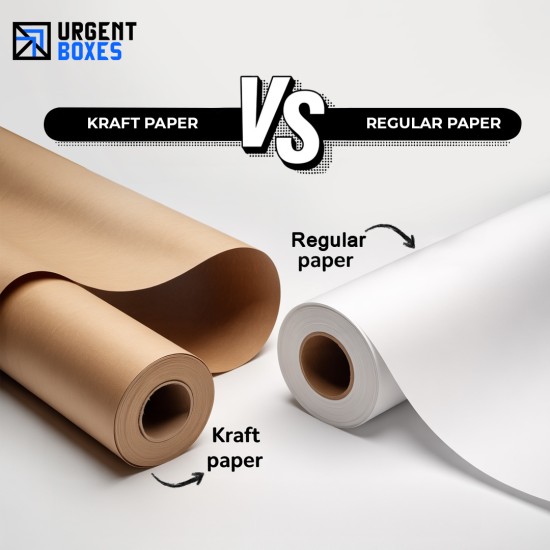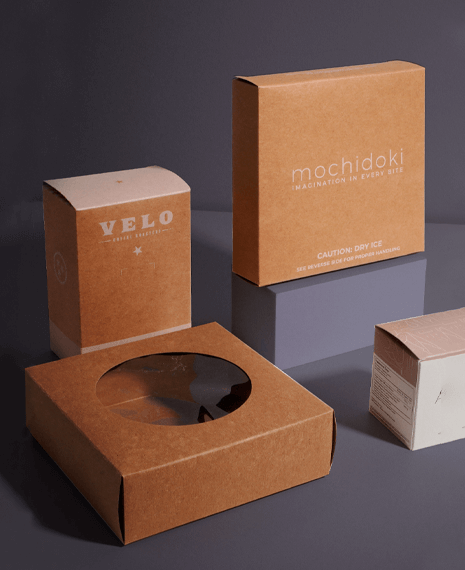In packaging, the key difference between Kraft paper and regular paper comes down to strength and purpose. Kraft paper is made using the Kraft pulping process, which retains more of the wood’s natural fibers that giving it superior durability, tear resistance, and eco-friendly qualities. That’s why it’s widely used for boxes, wrapping, and protective packaging.
Regular paper, however, undergoes more bleaching and refining, making it smoother and lighter, but less durable. It’s ideal for labels, inserts, and printing, not for heavy-duty packaging.
What is Regular Paper?
A regular paper is one that is used daily for daily writing, printing, and office work. It is made from wood pulp that is refined and treated to produce smooth, white sheets. The primary purpose is communication and documentation, rather than packaging. Moreover, it is lightweight and best suited for wrapping sheets and paper bags.
What is Kraft Paper?
Kraft paper is stronger and more durable than regular paper. This kraft is produced through the pulping process. The wood pulp is purified with chemicals to create long, strong fibers. In this way fiber gives the paper its natural brown color and high tear resistance. Kraft paper is widely used for eco-friendly packaging solutions. You can craft kraft paper bags, paper wrappers, and kraft boxes. It is also an alternative to plastic material.
Check out our detailed guide — What is Kraft Paper? How It’s Made (Complete Guide)
Key Differences Between Kraft and Normal Paper
1. Appearance
Regular paper is usually white, bright, and smooth. It makes this paper ideal for printing documents and colorful designs. On the other hand, Kraft paper have a thick texture and a brown shade. This gives a rustic and natural look. This earth style appeals to brands that want to highlight eco-friendly values.
2. Strength and Durability
Regular paper is delicate in nature and can tear easily. This cannot carry the heavy products. Kraft paper is more durable than regular paper. It is strong and has unbleached fiber. It can withstand weight, puncture, and rough handling during shipping. This is why many e-commerce and retail brands prefer Kraft packaging.
3. Production Process
Regular paper requires bleaching and heavy chemical treatment. So, it becomes less sustainable. The application of chemicals increases their environmental impact. Kraft paper passes through a minimal bleaching process. It can retain most of its natural fibers, which gives it a natural look. The less use of chemicals minimizes the waste. Therefore, it becomes a perfect choice for eco-friendly packaging.
4. Cost
A regular paper is less expensive for production and purchase. However, kraft paper provides better value for packaging due to its strength and other benefits. Companies often consider Kraft investing in paper to enhance quality and sustainability.
Regular Paper Packaging Applications
Although Kraft dominates the paper packaging, the paper also plays a common role. Some common uses include:
- Package sheet for delicate objects such as gifts or flowers.
- Labels and stickers are ideal due to their smooth, printed surface.
- Light paper bags for small goods in stores.
- Tissue paper for product presentation in gift boxes.
- Regular paper is best suited for mild or decorative packaging, as it avoids shipping heavy fees.
Packaging Applications of Kraft Paper
Kraft paper has gained popularity in industries due to its versatility. Some of the most common uses are:
- Shopping bags that can handle heavy groceries or fashion articles.
- Corrugated boxes made of kraft lines for the delivery of e-commerce.
- In Food industry kraft goes well for packaging of fast-food items and baked goods.
- You can use it to pack delicate objects like glasses or ceramics.
- This is Eco-friendly packaging option for brands that want sustainable solutions.
Curious why so many brands choose this material?
Discover the full insight in our blog — Why People Prefer Kraft Material for Custom Packaging
Sustainability Comparison of Kraft and Normal Paper
Kraft Paper Gives Eco-Friendly Edge
The brands that want safe packaging solutions choose kraft paper. It is recyclable, biodegradable, and compostable. The production of kraft uses fewer harmful chemicals. The sustainability of this paper enables easy and repeatable recycling. It can be recycled several times before losing strength. Many brands utilize Kraft packaging to align with their green initiatives and appeal to eco-conscious customers.
Common Paper and Its Environmental Effects
Regular paper is also recyclable. The bleaching process used during production causes additional environmental damage. Chemicals used to make paper bright and smooth often produce ecological toxins. Although it can be reused, it does not offer the same level of eco-gain as Kraft paper.
Printing on Kraft Paper vs White Paper
Packaging provides the best platform to show your brand details. It allows you to establish a lasting relationship with your customers. This conveys the brand's identity, values , and history. The type of packaging you choose can impact your marketing game. It leaves a lasting impression on your customers before they open the product. Here, we provide a comparison of both regular paper and kraft paper in terms of branding.
Consider Cost Factor While Choosing the Right Paper
Cost Effectiveness: Regular paper
Regular paper is generally cheaper and works well for light packaging or for use for a short time. If your products do not require heavy safety, this is a good option. However, it can easily be damaged during shipping, especially with heavy objects. This can lead to product loss, customer complaints, or returns. In the end, you may incur extra costs over the long run.
Cost Efficiency: Kraft Paper
Kraft paper may have a slightly higher cost, but it goes a long way. It is robust and durable. It can handle heavy products and rough shipping conditions without tearing, as better product protection reduces craftsmanship and the possibility of returns. Over time, custom kraft boxes can save money and improve customer satisfaction. Therefore, it is a wise investment for companies seeking quality and reliability in their packaging.
What is the Paper Packaging Future
With the global shift, the use of paper packaging is rising. Customers are becoming of conscious about the packaging material. Thus, brands are selecting packaging types that best suit their product and brand goals. In this scenario, Kraft paper is expected to continue dominating the packaging market in the future. However, a regular paper will still be necessary for presentation and creative branding. Together, they can complement each other - for example, a kraft box with a regular paper insert or wrap can balance power with aesthetics.
Final Note
The roles of regular paper and kraft paper differ. Both have their importance in terms of strength and other goals. However, the main difference lies in their purpose:
- Kraft paper is perfect for strong, environmentally friendly, and protective packaging.
- Regular paper is smooth, decorative, and ideal for light packaging and printing.
When deciding between the two, consider the product weight, shipping requirements, brand values, and customer expectations. Packaging is the face of any brand, so choose wisely to get an edge on others. You can contact Urgent Boxes to get the right solutions for your products. Contact our professionals for more information.





